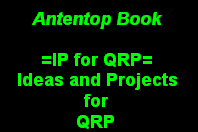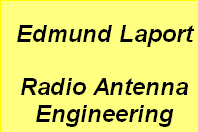


Antentop is FREE e-magazine devoted to Antennas and Amateur Radio an
Special page devoted to
80/40 meter CW Transmitter

Custom Search
|
ANTENTOP-
01- 2005, # 007 |
80/40
meter CW Transmitter
|
|
|
|
|
|
|
|
|
|
|
|
by
Jan, SM5GNN Credit
Line: http://www.algonet.se/~janax/ecl82bug.htm |
|
|
|
|
This is
my own variation of the triode/pentode family of glowbug transmitters.
It features a Pierce oscillator which runs continously during
transmit to avoid chirp. The PA is grid block keyed and since
the negative is there, fixed bias. The bias setting is not critical,
grid rectification will provide additional bias and form a sort
of regulation network. The PA is biased into class C,
adjust bias for about -24V at keydown, measured at the junction
of the 3 resistors. Plate current should be around 35-40 mA when
fully loaded, depending on crystal activity. Power output is 5
to 8W at 12W input which is a healty
66% efficiency (not counting the screen current) and a nice blue
glow comes from the innards following the keying. My original
plan was to use a Pi-L tank to meet the modern demand of spectral
purity but with loaded Q higher than normal, not really needed
in this power class. The idea with grid blocking was to enable
me to use my keyer without any relay in between. It has a negative
keying line with a 250V filledstate device behind. When tuning up, mesh the loading condenser C2 fully
and dip the plate with the tuning condenser C1, quickly! Plate
current should dip down to around 20 mA. Unmesh tle loading condenser
C2 until the current just stops rising or maximum 40 mA. Redip
the plate. Repeat until the dip is shallow, a few mA. Do not tune
for maximum output, the PA is not neutralized and will run beyond
maximum tube ratings if this is done. If maximum output goes over
9W or loaded plate current over 40 mA, lower the plate supply
or back off the grid condenser a little or mesh the loading condenser
a little. The plate current should not exceed 40 mA fully loaded
(ah, well, the tube is still available from T/R
switch? I use a rotating switch
with 3 poles, one for switching the antenna, one for+300V on/off
and one for the receiver mute. If you use a regenerative tube
receiver, antenna switching isn't really necessary, use a separate
short wire as RX antenna or couple lightly to the TX tank. The
regen grid leak and coupling condenser should be adjusted for
proper recovery between the code elements (full QSK) |
or perhaps between words.
Only a simple rocker for the +300V is needed. Spotting? Well, my Heath SB301 gives this away for free. Set the RX in receive
mode and engage the T/R switch without keying. You will hear the
triode oscillating in the receiver. Tune it in and reset the RX
in standby mode again. Advantage, gridblock! Running rock bound?
Not easy. You call CQ. Don't wait on the rock QRG for others unless others
knows about you. Sometimes you hear another
station calling CQ near your rock QRG. Give him a try, he may
hear you. It might be easier to use the QRP QRG 3560 kHz. In US,
3579 kHz is a common rock QRG. Use a 3579R545 kHz color burstie
rubbed down a tad. In EU at night, most glowbugs seem to stay
around 3560-3565 kHz. |
|
|
|
|
Page 79 |
|
79 80
 |
 |
 |
 |
Just for Fun:

Powered byIP2Location.com
Thanks for your time!
Last Updated:
February 22, 2020 22:21




